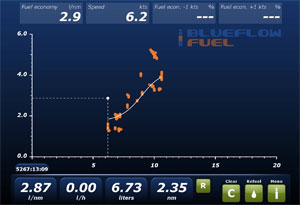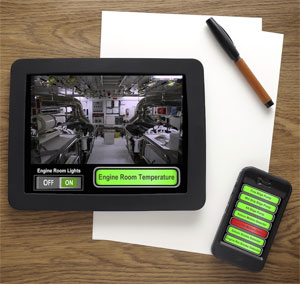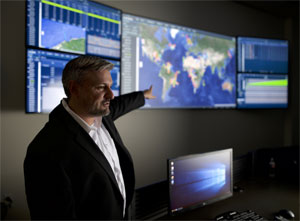Fuel and engine monitoring is a growing tool to help vessel operators improve efficiencies. Often, emissions reduction is a side benefit. While hardware is ultimately central to the systems, the software aspects have seen most of the recent developments.
By strengthening their view of operational performance, companies can more accurately evaluate fuel use, improve accounting and inventory control, and dictate better throttle management. An unspoken problem that monitoring systems can help address is pilfering of fuel supplies, and accurate monitoring also can be useful in detecting and assessing leaks and spills.
According to a recent report from ResearchAndMarkets.com, the marine engine monitoring market had an estimated value of $508 million in 2018. The report projects that it will grow to $656 million by 2025, in large part due to the increase in international seaborne trade and the rise in demand for deliveries of “smart” engines. Significant growth in the near future also will be driven by factors such as a rise in usage of inland waterways, and technological innovations in marine propulsion systems. A factor potentially restraining market growth, according to the report, is the lack of common data standards in the industry.
One of the leading purveyors in the monitoring market is Texas-based FuelTrax, which offers systems with a wide range of capabilities. Among them is FuelNet Generation 5, a data processing network that helps vessel owners customize their analysis and incorporate weather information that is time-stamped and linked to vessel location.
Launched 15 years ago, FuelTrax began life as a custom project for Kirby Corp., one of the nation’s most prominent inland waterway operators. Kirby wanted to better measure fuel consumption on its pushboats. Control Dynamics International (CDI), an engineering company, delivered a solution.
 |
|
Blueflow Onboard, from Swedish startup Blueflow Energy Management, integrates with other ship systems and flow meters to monitor fuel consumption and other parameters in real time. The information is sent to Blueflow Online for reporting, analysis and verification. |
|
Courtesy Blueflow Energy Management |
Only later did CDI recognize that Kirby’s problems were far from unique, leading the monitoring provider to spin off Nautical Control Solutions (NCS) in 2006 to further develop what it had designed. Victoria Cantu, head of business development at FuelTrax, said it was a fortunate move as interest in the marine sector grew for digital tools to better manage operations through data and automation.
Cantu said the company’s products are in use on more than 500 vessels worldwide. Making the most of all of the data from all of those vessels, Cantu said the company is sifting through the information to create benchmarks for performance. The anonymous database will allow FuelTrax users to evaluate how their vessels are operating compared to other users.
FuelTrax displays data in easy-to-understand ways so that users are able to comprehend it in seconds. The net result, according to Cantu, is that customers usually achieve a fuel savings of 6 to 10 percent. “It is like a gym membership — the more you use it, the more you will get out of it,” she said, adding that a typical return on investment (ROI) is achieved within six months.
Among the other companies vying for market share is Louisiana-based Sentinel Marine Technology, which offers monitoring systems that handle data collection, display and recording of each vessel’s engine fuel consumption, as well as a comparison to historical data. The system also generates customizable reports. Stand-alone sensors monitor the fuel consumption of individual engines and can interface directly with the engine control module for vessels so equipped. The company also offers a wide range of products for monitoring other marine equipment.
Blueflow Energy Management, a recent startup based in Sweden, has deployed its systems on several vessels in Europe to record and analyze fuel consumption and generate reports. The Blueflow system can integrate with flow meters and other onboard equipment to provide real-time monitoring.
 |
|
Maretron’s N2KView Mobile software allows operators to remotely monitor and control vessel systems from a smartphone or tablet. Fuel flow monitoring helps identify optimal settings to achieve savings. |
|
Courtesy Maretron |
Maretron, which recently merged with Carling Technologies, offers engine monitoring products that can be set up to provide alerts and alarms, and they can be customized as required. The company also provides fuel flow monitoring that helps identify optimal settings to achieve fuel savings. According to Kip Wasilewski, director of sales at Florida-based Maretron, the company’s fuel monitoring solutions can evaluate tank levels and speed, and provide data logging in addition to keeping an eye on consumption. In addition, he explained, Maretron user interface products can calculate miles per gallon, DTE (distance to empty) and range when the vessel is outfitted with the appropriate sensors.
FloScan, another notable market participant, was bought out last year and is currently under new ownership. A new line of marine gas and diesel fuel monitoring instrumentation is in the works and should be available in several months.
Other companies in the marine engine monitoring market include ABB (Switzerland), AST Group (United Kingdom), Caterpillar (U.S.), Cummins (U.S.), Emerson (U.S.), Hyundai Heavy Industries (South Korea), Jason Marine Group (Singapore), Kongsberg (Norway), MAN Diesel & Turbo (Germany), Mitsubishi Heavy Industries (Japan), NORIS Group (Germany), Rolls-Royce (U.K.) and Wartsila (Finland).
Despite the number of companies in the market, increasingly complex management challenges on the water likely mean there is still room for growth.
“What we are seeing clients focus on more is not just data or automation, but the quality and accuracy of the data,” Cantu said. “They are not just interested in data but information that will tell them how to improve operations.”

